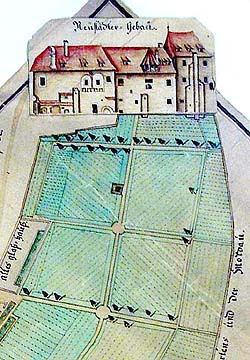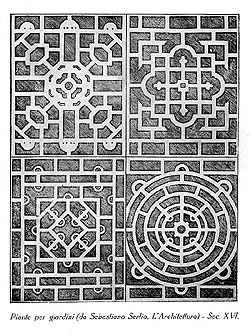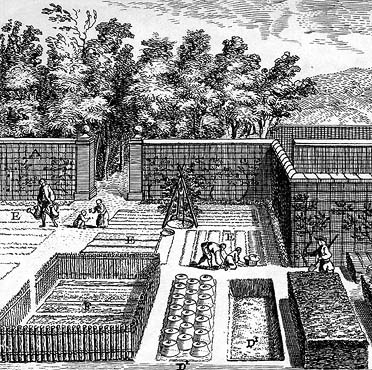New Town (Novoměstská) Garden during the reign of the Rožmberks
Chronological source outline of the garden's development:
- 1546 - Probable beginning of the New Town Garden
building
- 1594 - Peter Vok begins to modify the mansion and the
garden
- 1597 - "The wall to the birdhouse and the wired bars as well as
the balconies on the walls of the mansion were built in order to
create access to the birdhouse and so that the birds would be not
only heard but also seen and so then, when it was all finished, a
joyful and various loud singing could be surprisingly heard from
there."
- 1597 - "The townsmen initiated a new wall construction, for the
old one was destroyed by the water."
- 1600 - "By the same mansion there was a beautiful garden, in
which various trees including vlaske, orange, lemon, fig and other
trees as well as various spices were grown. There were three
hatcheries in the same garden, into which sparkling water flowed,
and in which the trouts and other kinds of fish were kept. There is
one water tank made of stone in the middle of this garden. In the
same garden there is a second new-built house in which there are
nice cellars and rooms for the gardener (No.26). And by this
mansion there are also two new relaxing centres
(lusthauses)."
- 1602 - On 25, August 1602 a new inventory of the tree and
flower trees and flowers growing in the garden was made. The
inventory is a detailed description of the garden in its state
during the reign of the last Rožmberks, but especially in the reign
of Peter Vok, who loved gardens.
Except the list of species, the inventory contains records about the inner division of the garden area into the five departments ("preserves") and a greenhouse mentioned there as an "orange mine". Their detailed description is a unique historical source that, among other things, proves the attention the last Rožmberks paid to the garden. The list of the species grown there is extraordinary long.
In the greenhouse grew the above mentioned orange, lemon, and fig-trees, but also laurels, kdoulone, cypresses, roses and other plants. In the front preserve, which was lined with the box-tree live fences, grew mispule, cherry, peach, plum and French plum-trees. As for the bushes there grew gueslder rose, herbs like mint-balm, sage, mint, fox-glove, and lavender. There were also various flowers: violets, peony, daisies, daffodils, lilies, snapdragon, golden lily, carnations, larkspur, royal yarrow and columbine. The second preserve was also planted with a similar mix of trees and flowers. A maze made the third preserve. There grew mirabelle, apricots, plums, cherries and sour cherries. Roses and royal brushwood grew as decorative plants there. Lavender and yallow represented the aromatic plants. Some vegetables were also grown there - cabbage and parsley. The fence and perhaps the maze walls were made of box-trees. In the forth preserve with a box-tree walls there were plum-trees, French plum-trees, sour cherry and cherry-trees, flowers, herbs and also some kinds of vegetables, for example cucumbers, cabbage and beets. This was followed by a birdhouse (foglhauz), in which cranes, turtle-doves, blackbirds, fieldfares, and many other kinds of birds were kept. Around the aviary grew roses, bushes of currants, cabbage and strawberries. A fountain in which the trouts were kept was situated nearby. The fifth preserve, the so-called kitchen garden, was used for growing vegetables: e.g. artichokes, cucumbers, cabbage, strawberries, zucchini, asparagus, sage, green peas, red beets, radish, chicory, spinach and cauliflower. Some fruit trees were also planted there - cherry, sour cherry, plum and French plum trees.
Urban development of the location:
The flat meadow around the River Vltava, threatened by floods, had
been used as a temporary settlement since the Old Ages - see e.g.
the foundings of the Slav midground settlement (polozemnice) from
the 8th century (
Archaeological findings in the Brewery garden). The New Town
garden was later on, in the 16th century, founded on an area which
probably had not been a part of the Latrán outer bailey settlement,
surrounded by a city wall. The change of the urban situation was
caused by the extensive foundation of the Clarissian and Minorite
monasterie (
Latrán No. 50). The contrast in the Latrán ground plan between
"organically" grounded outer bailey settlement, which was
concentrated along the only communicative axis in arches and a
one-time founded monastery place, typical for its usage of
classical principles for the creation of the monastery buildings
set has been visible until today. The New Town was founded between
1347 and 1374; the name itself was first used in the middle of the
15th century. From the very beginning, the New Town development was
influenced by the earlier founded monasteries - houses and streets
were created around its circumference and the new buildings were
not as compact as in the neighbouring Latran. It is probable that
there were dispersed settlements, gardens and hatcheries in the
place of later New Town Gardens. Originally, there was a row of
houses in the place of today's brewery. In 1462 the Rožmberks
bought a court with a garden there, which became the basis for the
later mansion (
Latran No. 27). In the years 1546 - 1559 this mansion was
expanded and rebuilt into an imposing widow's residence with a
garden belonging to Anna of Roggendorf. The garden gained its
today's area by gradual buying of townsmen's land, however, there
are no clear news about its form in the time of Mrs. Anna (she died
in 1562). The New Town Garden reached its peak later on during the
reign of her sons Wilhelm
of Rožmberk and especially Peter
Vok of Rožmberk, who in the middle of the 1590's initiated an
important modification of the New Town Garden.
Historical and architectural development of the New Town
Garden during the the reign of the Rožberks:
We do
not have any further news about the oldest phase of the garden's
development associated with Anna Roggendorf's stay in the
neighbouring mansion. At that time, the garden probably had a late
middle-age character of a town garden, where the useful areas were
freely mixed with decorative plants. In the time of the reign of
Wilhelm of Rožmberk and especially of Peter Vok, the garden changed
into a very precious Renaissance garden. Much bigger attention was
probably paid to equipping the New Town Garden than the gardens
above the castle and the garden in the isle in the castle's pond.
It was called the "lower garden in the New Town" in order to
discriminate it from these other gardens.  The garden was connected
to the castle by a covered corridor system, so the accessibility
for the nobility was easily accessible. The modifications initiated
by Peter Vok after the year of 1594 brought a spirit of mannerism
to Cesky Krumlov. The authors of the modification concept are not
known. It is possible that it was inspired by a contemporary
Empirical garden in Brandys nad Labem or the Royal preserve in
Prague Bubenec. We suppose that Domenico
Benedetto Cometa, who worked for Peter Vok in Český Krumlov at
that time, participated in the garden works. The orangery, the
second oldest in Bohemia and in the Central Europe, is mentioned in
the year of 1600. Towards the end of the 16th century the New Town
Garden was well known for an amount of plant species (including the
exotic ones) grown there. The orangery in the lower garden was the
second oldest orangery in Bohemia. This fact illustrates the
interest the Rožmberks had in gardens and in nature sciences
generally. The 1602 inventory of this garden is the most valuable
source for getting to know the form of the so-called lower garden
in the Rožmberk time. Although the Czech king (and Emperor) Rudolf
II possessed the garden and the whole manorial estate at the time
the inventory was made, it nevertheless illustrates the likeness of
the Rožmberks' garden - almost nothing important was done in the
garden in one year of Emperor's administration. The "low garden in
the New Town" inventory from 1602 introduces us to the Rožmberk
garden in its most valuable developmental phase, when the garden
architecture was already influenced by a spirit of the late
Renaissance and mannerism. According to the inventory, the New Town
Garden contained the elements typical for the Renaissance gardens
as area fencing by a boundary wall, arranged into regular parts
bordered by box-tree fences. There was a maze, aviary and a stone
water tank there. The greenhouse (the so-called fighouse or also
orangery) and other garden constructions were situated by the
northern wall of the garden. The inventory also contains a simple
operational garden plan. The front garden, the second garden, a
maze, the fourth garden, the birdhouse with a water tank and the
kitchen garden followed from the mansion in this gradual order. The
irregular shape of the land complicated the building of a strictly
geometrical and axis-connected path system and caused the formal
shortnesses of the New Town Garden. The garden plans from the later
times (from the 18th century) still prove the rough area outline
and the placement of some garden constructions.
The garden was connected
to the castle by a covered corridor system, so the accessibility
for the nobility was easily accessible. The modifications initiated
by Peter Vok after the year of 1594 brought a spirit of mannerism
to Cesky Krumlov. The authors of the modification concept are not
known. It is possible that it was inspired by a contemporary
Empirical garden in Brandys nad Labem or the Royal preserve in
Prague Bubenec. We suppose that Domenico
Benedetto Cometa, who worked for Peter Vok in Český Krumlov at
that time, participated in the garden works. The orangery, the
second oldest in Bohemia and in the Central Europe, is mentioned in
the year of 1600. Towards the end of the 16th century the New Town
Garden was well known for an amount of plant species (including the
exotic ones) grown there. The orangery in the lower garden was the
second oldest orangery in Bohemia. This fact illustrates the
interest the Rožmberks had in gardens and in nature sciences
generally. The 1602 inventory of this garden is the most valuable
source for getting to know the form of the so-called lower garden
in the Rožmberk time. Although the Czech king (and Emperor) Rudolf
II possessed the garden and the whole manorial estate at the time
the inventory was made, it nevertheless illustrates the likeness of
the Rožmberks' garden - almost nothing important was done in the
garden in one year of Emperor's administration. The "low garden in
the New Town" inventory from 1602 introduces us to the Rožmberk
garden in its most valuable developmental phase, when the garden
architecture was already influenced by a spirit of the late
Renaissance and mannerism. According to the inventory, the New Town
Garden contained the elements typical for the Renaissance gardens
as area fencing by a boundary wall, arranged into regular parts
bordered by box-tree fences. There was a maze, aviary and a stone
water tank there. The greenhouse (the so-called fighouse or also
orangery) and other garden constructions were situated by the
northern wall of the garden. The inventory also contains a simple
operational garden plan. The front garden, the second garden, a
maze, the fourth garden, the birdhouse with a water tank and the
kitchen garden followed from the mansion in this gradual order. The
irregular shape of the land complicated the building of a strictly
geometrical and axis-connected path system and caused the formal
shortnesses of the New Town Garden. The garden plans from the later
times (from the 18th century) still prove the rough area outline
and the placement of some garden constructions.
The 1764 garden plan contains a geometrical outline of the kitchen garden, which corresponds with the garden description in the 1602 inventory. The above mentioned first, second, third and fourth "preserve" probably correspond to four bosquets, which the 1764 plan places in front of the mansion:
- the first garden was from the mansion view placed on the front
northern bosquet, there was also a narrow area of open roof
orangeria in its neighbourhood at the end of the 18th
century
- the second preserve was probably situated in the area of front
southern bosquet
- the third preserve (the maze) would be placed behind the first
preserve by the garden's northern wall
- the forth preserve was probably situated in the area of a back southern bosquet, the birdhouse that is supposed to be situated behind the forth preserve was probably situated on the crossing of a main garden axis and a perpendicular axis to it behind the third ant forth preserve - the main axis was turning in this point like in a "joint".
 It is hard to determine
from the archive records whether the kitchen garden reached all the
way to the New Town Garden western wall or if the Rožmberk garden
ended at the level of the court gardener's house (
Latran No. 26)
It is hard to determine
from the archive records whether the kitchen garden reached all the
way to the New Town Garden western wall or if the Rožmberk garden
ended at the level of the court gardener's house (
Latran No. 26)
The rich structure of the preserves in the New Town Garden - a mixture of fruit trees, bushes, herbs and decorative plants - witnesses the last marks of the middle-age garden conceptions. In the group of Renaissance types of garden areas, the New Town Garden can be perhaps best marked as "giardino de simplici", a garden with a mixed useful and decorative character. It was frequently divided by a rectangular path system into the four square beds, lined with a low box-tree fence. The beds themselves were planted with flowers and decorative trees, the squares were complied with the arbours.
Analysing the New Town Garden composed structure and the archive sources concerning its form, we find that one fundamental element of Renaissance gardens - a parter - was missing, at least in its intact form. A parter was usually located under the windows of the garden front-side of the palace construction. It was made of square fields of the same size, lined with the box-tree fences, separated by the paths of the same width. The inner area of the individual fields was filled with a symetrically composed ornament from the low-cut box-tree fences. The square fields were less frequently composed of geometrically shaped beds, planted with aromatic plants and herbs, vegetables and flowers. The 16th century beds are typical for a striking limitation of elements used for the creation of inner bed decoration of belts and ribbons. The usual architectural motives of arabesque and grotesque of that time were not applied to the bed-forms. The New Town Garden maze was probably planted with box-tree fences. However, the inventory mentions also the fruit trees, bushes, herbs and even vegetables. It was not probably a clean type of maze but rather its variation created in (from the point of view of the garden creation level) in a somewhat provincial surrounding. Although the Cesky Krumlov New Town Garden did not reach the formal and especially composical refinement of the Prague Royal Garden, it can be considered as one of the most valuable municipal palace gardens of its time in the Czech lands.
Further information:
The New Town Garden in the 17th century
The New Town Garden in the 18th and 19th centuries
The New Town Garden - buildings and vegetation


